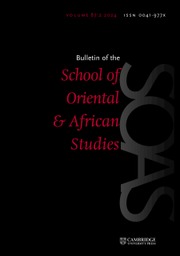No CrossRef data available.
Article contents
“Melt” and the labial causative in Gyalrongic
Published online by Cambridge University Press: 26 June 2025
Abstract
This brief article explores forms for the verb “melt” in Gyalrongic languages, demonstrating that they are cognates and not Tibetan loanwords. Clarification is made on a phonological rule in Japhug, where w- transforms to m- following a nasal, merging the nasal and w-. The article also suggests that the preinitial m- in Mazur Stau and Geshiza is a fossilized autive prefix, possibly resulting from independent changes or language contact. Additionally, Tangut, Bawang, and Puxi Stosde’s usage of a labial medial -w-/-v- for “melt” is hypothesized as an ancient labial causative infix.
Information
- Type
- Article
- Information
- Copyright
- © The Author(s), 2025. Published by Cambridge University Press on behalf of SOAS University of London.
References
Bahrt, Nicklas N. 2021.
Voice Syncretism
. (Research on Comparative Grammar.) Berlin: Language Science Press.Google Scholar
Gates, Jesse. 2012. “Situ in situ: towards a dialectology of Jiāróng (rGyalrong)”. Master’s thesis, Trinity Western University.Google Scholar
Gates, Jesse P. 2021. “A grammar of Mazur Stau”. PhD thesis. Paris: École des Hautes Études en Sciences Sociales.Google Scholar
Gates, Jesse P., Honkasalo, Sami and Lai, Yunfan. 2022. “From transitive to intransitive and voiceless to voiced in Proto-Sino-Tibetan: new evidence from Stau, Geshiza, and Khroskyabs”,
Language and Linguistics
23/2, . URL https://www.jbe-platform.com/content/journals/10.1075/lali.00104.gat.Google Scholar
Honkasalo, Sami. 2019. “A grammar of Eastern Geshiza: a culturally anchored description”. PhD thesis, Helsinki: University of Helsinki.Google Scholar
Jacques, Guillaume. 2014.
Esquisse de phonologie et de morphologie historique du tangoute
. Leiden: Brill.CrossRefGoogle Scholar
Jacques, Guillaume. 2015. “The spontaneous-autobenefactive prefix in Japhug Rgyalrong”,
Linguistics of the Tibeto Burman Area
38/2, .CrossRefGoogle Scholar
Jacques, Guillaume. 2019. “The labial causative in Trans-Himalayan”, Journal of the
Southeast Asian Linguistics Society
12/1, 1–11.Google Scholar
Jacques, Guillaume. 2021.
A Grammar of Japhug
. (Comprehensive Grammar Library). Berlin: Language Science Press.Google Scholar
Jacques, Guillaume, Antonov, Anton, Yunfan, Lai and Nima, Lobsang. 2017. “Stau (Ergong, Horpa)”, in Thurgood, Graham and LaPolla, Randy (eds),
The Sino-Tibetan Languages
(2nd edition), 597–613. London: Routledge.Google Scholar
Kulikov, Leonid. 2010. “Voice typology”, in Son, Jae Jung (ed.),
The Oxford Handbook of Linguistic Typology
. Oxford: Oxford University Press. https://doi.org/10.1093/oxfordhb/9780199281251.013.0019.Google Scholar
Lai, Yunfan. 2017. “Grammaire du khroskyabs de Wobzi”. PhD thesis. Paris: Université Paris III.Google Scholar
Payne, Thomas Edward. 1997.
Describing Morphosyntax: A Guide for Field Linguists
. Cambridge: Cambridge University Press.CrossRefGoogle Scholar
Prins, Marielle. 2016.
A Grammar of rGyalrong Jiaomuzu (Kyom-kyo) Dialects, A Web of Relations
. Leiden: Brill.CrossRefGoogle Scholar
Sun, Jackson T-S. 2007. “Morphological causative formation in Shangzhai Horpa”,
Bulletin of Chinese Linguistics
2/1, .CrossRefGoogle Scholar
Sonam Lhundrop, Tunzhi. 2017. “Language vitality and glottonyms in the Ethnic Corridor: The rTa’u language”,
International Journal of the Sociology of Language
245, .Google Scholar
Sonam Lhundrop, Tunzhi. 2019. “Outline of Bra’go variety of rTa’u (Horpa)”. PhD thesis, Melbourne: La Trobe University.Google Scholar
Yang, Chih-Fan. 2021. 巴旺霍爾語時、體、示證、情態範疇的形態句法 [The morphosyntax of tense, aspect, evidentiality and modality in Bawang Horpa]. Doctoral thesis, Taipei: National Taiwan Normal University.Google Scholar
Zhang, Shuya. 2020. “Le rgyalrong situ de Brag-bar et sa contribution à la typologie de l’expression des relations spatiales: l’orientation et le mouvement associé”. Doctoral thesis. Paris: Institut National des Langues et Civilisations Orientales. URL https://hal.science/tel-03132628.Google Scholar
Zúñiga, Fernando and Kittilä, Seppo. 2019.
Grammatical Voice
. Cambridge: Cambridge University Press.CrossRefGoogle Scholar


